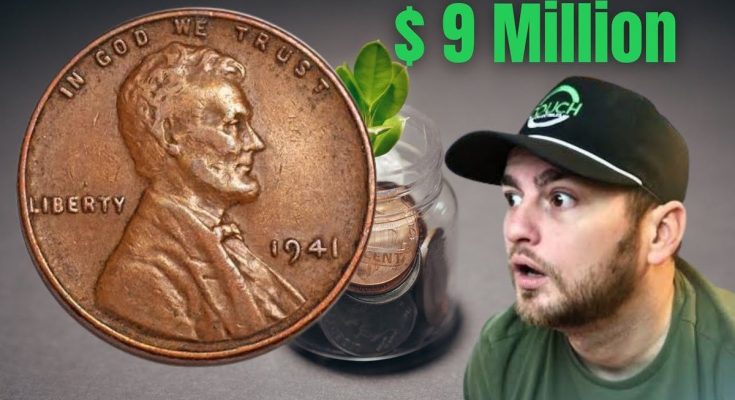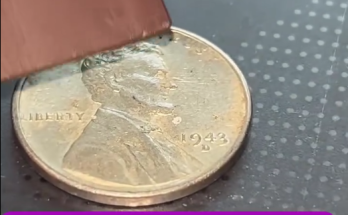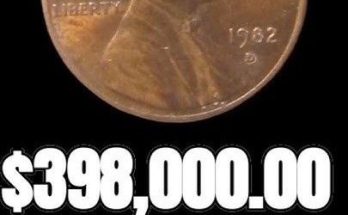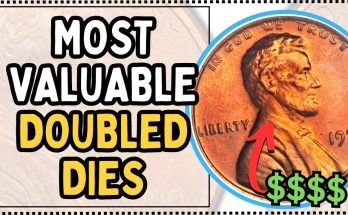This image captures the thrilling potential hidden in everyday pocket change, focusing on a magnified 1941 Lincoln Wheat Penny alongside a shocked coin collector, all framed by an astonishing “$9 Million” price tag. While the search for an authentic 1941 Steel Penny is based on a common misconception—as steel cents were officially minted only in 1943—the photo draws attention to genuinely rare 1941 coin errors and varieties that can fetch thousands, even tens of thousands, of dollars! This is the definitive guide to the 1941 penny varieties that serious coin enthusiasts actually look for.
The $9 Million Question: Is There a Real 1941 Steel Penny?
Let’s address the caption’s bold claim first. The U.S. Mint produced the famous steel cents only in 1943 to conserve copper for the war effort during World War II. Therefore, a genuine 1941 penny made of steel should not exist and is almost certainly a counterfeit or a normal copper penny plated with a metallic coating after it left the mint.
However, the image’s shocking value ($9 Million is an extreme exaggeration, but high values are real!) is meant to highlight a rare coin that could be just as valuable as an unconfirmed legend. The most valuable pennies are often those struck with an error—a mistake made during the minting process that transforms a common coin into a numismatic rarity.
The True Millionaire-Maker: The 1941 Doubled Die Obverse (DDO)
Forget the mythical steel coin; the real jackpot is the 1941 Doubled Die Obverse (DDO). This error occurs when the coin’s die is struck multiple times, creating a slightly overlapping, doubled image on the coin’s face (the obverse).
What to Look For:
- Doubling: Carefully inspect the lettering on the obverse, particularly the words “IN GOD WE TRUST,” “LIBERTY,” and the “1941” date. The doubling is often most noticeable on the serifs or edges of these letters.
- Grades and Value: A high-grade, uncirculated 1941 DDO in ‘Red’ condition (meaning it retains its original, bright copper color) is the peak of collectibility. Depending on the severity and visibility of the doubling, authenticated examples have sold for anywhere from a few thousand dollars up to and beyond $35,000! The higher the grade (MS-65 or better) and the stronger the doubling, the higher the value climbs.
Other Valuable Varieties to Search For:
While the DDO is the star, several other conditions and errors can make a 1941 penny worth a significant premium over its face value:
- High-Grade ‘Red’ Coins (MS-65+): Even a standard 1941 copper cent (minted in Philadelphia, Denver, or San Francisco) that has never been circulated and retains its original copper luster—graded as “Mint State Red” (MS-65 RD or higher)—is highly sought after. Because over a billion 1941 pennies were minted, finding one in absolutely pristine condition is surprisingly difficult, and these coins can sell for hundreds or even thousands of dollars.
- Off-Center Strikes: Look for coins where the design is struck significantly off-center, making part of the date or design disappear over the edge. These errors increase in value the more off-center they are, especially if the full date (1941) is still visible.
- Repunched Mint Marks (RPMs): Check the mint mark (D for Denver or S for San Francisco, located below the date). A Repunched Mint Mark occurs when the punch used to apply the mint mark strikes the coin planchet more than once, leaving a secondary, misaligned letter visible.
The Takeaway:
The excitement generated by a photo like this one is real, but the focus should shift from the non-existent “1941 Steel Penny” to the verifiably rare 1941 Doubled Die Obverse and pristine, high-grade examples. Your change jar could be hiding a five-figure treasure! Start by checking the date, then pull out a magnifying glass and closely inspect “LIBERTY,” “IN GOD WE TRUST,” and the “1941” date for that elusive doubling. Happy hunting!



